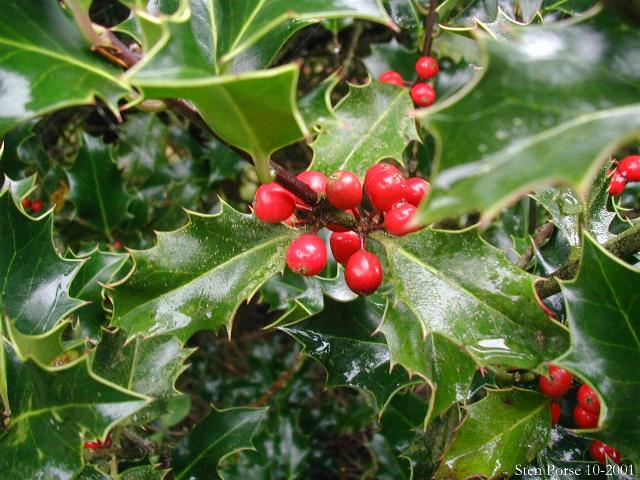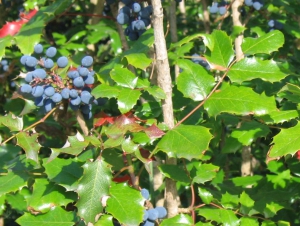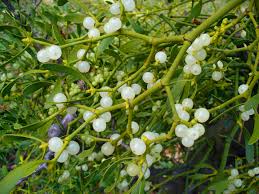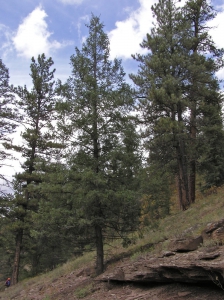European holly (Ilex aquifolium), family Aquifoliaceae
Mistletoe (Viscum album), family Santalaceae
Douglas Fir (Pseudotsuga menziesii), family Pinaceae
Article by Jeanne Gozigian
What all of these “Christmas Greens” have in common is that they are evergreens, retaining their green leaves throughout the seasons, wherever they may grow. For this reason, they have traditionally been adopted for decorating houses, public buildings, and businesses during the Christmas holidays. Perhaps they are meant to symbolize resurrection, hope, and life everlasting.

European holly (Ilex aquifolium)
But, what mistletoe and holly also have in common is that their use far predates their association with Christianity. The Druids wore holly wreaths on their heads to denote good fortune and hung mistletoe branches in their houses to bring good luck. They believed that mistletoe was associated with fertility. Neither of these plants is native to North America.
European holly is a small evergreen tree, native to laurel forests. The shiny alternate leaves have spiny, serrated edges, with bright red berries, technically drupes, as are stone fruits. The trees are dioecious; that is, male and female flowers form on separate plants of the European holly. Ilex in Latin means holm oak or evergreen oak, perhaps because of the leaf similarity. The berries can cause vomiting and diarrhea if ingested, particularly in children and the elderly. It is thought that Christian symbolism related the holly wreath to the crown of thorns worn by Jesus Christ on the way to his crucifixion. However, holly had a large place in the Druids’ winter solstice celebrations, long before Christianity.

Berberis aquifolium
One holly-like plant that does occur locally is Berberis aquifolium (synonym, Mahonia aquifolium), or Oregon grape, family Berberidaceae, which is an evergreen shrub with purple berries. It grows in zones 5-9 and can be found in our Rocky Mountains. There is an old English carol called “The Holly and the Ivy”, underscoring our mystical attachment to evergreens:
The holly and the ivy,
When they are both full grown
Of all the trees that are in the wood
The holly wears the crown.

Viscum album
Mistletoe is a hemiparasitic plant. It attaches itself to a host from which it attains its nourishment, often killing the host in the process, but is capable of photosynthesis at times. It has smooth, oval leaves and waxy, white berries. The tradition of kissing under a mistletoe branch originated in England; one broke off a berry after each kiss and when the berries were gone, no more kissing was allowed!
The name derives from Mistel (dung) and tan (twig or stick). The parasite is spread by means of bird dung deposited on host trees. Viscum album is not native to North America but has been successfully propagated in California, and an Eastern variety of mistletoe, Phoradendron leucarpum, occurs naturally. We also have a native mistletoe that infects pinon pines and has no berries, Arceuthobium divaricatum. Mistletoe is toxic to humans but provides food for birds. Another native mistletoe, juniper mistletoe, Phoradendron juniperum, infects some of the junipers at the Leonora Curtin Wetland Preserve.

Pseudotsuga menziesii variety glauca (Douglas Fir). Photo ©Al Schneider, www.swcoloradowildflowers.com
Douglas fir, Pseudotsuga menziesii, while a native of western North America, is not a true fir. Therefore, it should be known as Douglas-fir. True menziesii is a Pacific coastal variety of Douglas-fir. Our Rocky Mountain or interior Douglas-fir is P. menziesii var. glauca. It can attain a height of 197-246 feet. It has soft, 1 1/2 inch needles that radiate from the branches in all directions, producing a sweet fragrance when crushed. There are many Douglas-firs in the Santa Fe National Forest.
They are very shapely trees, so it is not surprising that their major use since the 1920’s is for Christmas trees. Most are grown on Christmas tree plantations. They are ready for harvesting in 7-10 years. Most plantation trees are cut long before Christmas, which is why one gets significant needle drop from “fresh” trees. This is a responsible use of a natural resource; replanting being done as soon as the season’s trees are cut.
We humans have a very long history of celebrating the beauty, and power to evoke emotions, of our evergreen treasures.
Sources:
Wikipedia
National Christmas Tree Association
USDA Forest Service
http://www.about.com/homegarden/
theplantlist.org
SOUTHWEST ENVIRONMENTAL INFORMATION NETWORK, SEINet. 2015. http//:swbiodiversity.org/seinet/index.php. Accessed on November 17.


